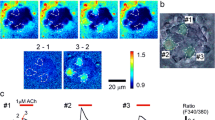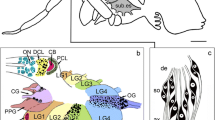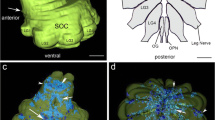Abstract
Acetylcholine (ACh) is well established as a neurotransmitter and/or neuromodulator in various organs. Previously, it has been shown by Ogura (J Neurophysiol 87:2643–2649, 2002) that in both physiological and immunohistochemical studies the muscarinic acetylcholine (ACh) receptor is present in taste receptor cells. However, it has not been determined if ACh is released locally from taste receptor cells and/or surrounding nerve fibers. In this study we investigated the sites of ACh release in mouse taste tissue using the antisera against vesicular ACh transporter (VAChT), a key element of ACh-containing vesicles. Our data show that VAChT-immunoreactivity is present in many taste receptor cells, including cells expressing the transient receptor potential channel M5 (TRPM5). In taste cells, VAChT-immunoreactivity was colocalized with the immunoreactivity to choline-acetyltransferase (ChAT), which synthesizes ACh. Additionally, enhanced green fluorescent protein (eGFP) was detected in the taste cells of BAC-transgenic mice, in which eGFP was placed under the control of endogenous ChAT transcriptional regulatory elements (ChATBAC-eGFP mice). Furthermore, many ChAT-immunolabeled taste cells also reacted to an antibody against the vesicle-associated membrane protein synaptobrevin-2. These data suggest that ACh-containing vesicles are present in taste receptor cells and ACh release from taste cells may play a role in autocrine and/or paracrine cell-to-cell communication. In addition, certain nerve fibers surrounding or within taste buds were immunoreactive for the VAChT antibody. Some of these fibers were also immunolabeled with antibody against calcitonin gene-related peptide (CGRP), a marker for trigeminal peptidergic fibers. Thus, functions of taste receptor cells could be modulated by trigeminal fibers via ACh release as well.





Similar content being viewed by others
References
Bo X, Alavi A, Xiang Z, Oglesby I, Ford A, Burnstock G (1999) Localization of ATP-gated P2X2 and P2X3 receptor immunoreactive nerves in rat taste buds. Neuroreport 10:1107–1111
Boucher Y, Simons CT, Faurion A, Azerad J, Carstens E (2003) Trigeminal modulation of gustatory neurons in the nucleus of the solitary tract. Brain Res 973:265–274
Brucke HV, Hellauer F, Umrath K (1948) Sur la nature cholinergique des bourgeons gustatifs de la papille foliee du lapin. Arch Int Physiol 55:362–365
Bruzzone R, Dermietzel R (2006) Structure and function of gap junctions in the developing brain. Cell Tissue Res 326:239–248
Caicedo A, Jafri MS, Roper SD (2000) In situ Ca2+ imaging reveals neurotransmitter receptors for glutamate in taste receptor cells. J Neurosci 20:7978–7985
Caicedo A, Kim KN, Roper SD (2002) Individual mouse taste cells respond to multiple chemical stimuli. J Physiol 544:501–509
Carlson SS, Wagner JA, Kelly RB (1978) Purification of synaptic vesicles from elasmobranch electric organ and the use of biophysical criteria to demonstrate purity. Biochemistry 17:1188–1199
Chang GQ, Vigna SR, Simon SA (1996) Localization of substance P NK-1 receptors in rat tongue. Regul Pept 63:85–89
Clapp TR, Stone LM, Margolskee RF, Kinnamon SC (2001) Immunocytochemical evidence for co-expression of Type III IP3 receptor with signaling components of bitter taste transduction. BMC Neurosci 2:6
Clapp TR, Yang R, Stoick CL, Kinnamon SC, Kinnamon JC (2004) Morphologic characterization of rat taste receptor cells that express components of the phospholipase C signaling pathway. J Comp Neurol 468:311–321
Clapp TR, Medler KF, Damak S, Margolskee RF, Kinnamon SC (2006) Mouse taste cells with G protein-coupled taste receptors lack voltage-gated calcium channels and SNAP-25. BMC Biol 4:7
Crescimanno C, Merigo F, Bernardi P, Osculati F, Sbarbati A (2004) Neurochemistry of the gustatory subgemmal plexus. Chem Senses 29:537–546
Damak S, Margolskee RF (2005) Transsynaptic transport of wheat germ agglutinin expressed in a subset of type II taste cells of transgenic mice. XXVIIth AChemS meeting abstract. Chem Senses 30:A196
Damak S, Rong M, Yasumatsu K, Kokrashvili Z, Perez CA, Shigemura N, Yoshida R, Mosinger B Jr, Glendinning JI, Ninomiya Y, Margolskee RF (2006) Trpm5 null mice respond to bitter, sweet, and umami compounds. Chem Senses 31:253–264
DeFazio RA, Dvoryanchikov G, Maruyama Y, Kim JW, Pereira E, Roper SD, Chaudhari N (2006) Separate populations of receptor cells and presynaptic cells in mouse taste buds. J Neurosci 26:3971–3980
Dowdall MJ, Boyne AF, Whittaker VP (1974) Adenosine triphosphate. A constituent of cholinergic synaptic vesicles. Biochem J 140:1–12
Erickson JD, Varoqui H, Schafer MK, Modi W, Diebler MF, Weihe E, Rand J, Eiden LE, Bonner TI, Usdin TB (1994) Functional identification of a vesicular acetylcholine transporter and its expression from a “cholinergic” gene locus. J Biol Chem 269:21929–21932
Farbman AI, Hellekant G (1978) Quantitative analyses of fiber population in rat chorda tympani nerves and fungiform papillae. Am J Anat 153:509–521
Finger TE (1986) Peptide immunohistochemistry demonstrates multiple classes of perigemmal nerve fibers in the circumvallate papilla of the rat. Chem Senses 11:135–144
Finger TE, Danilova V, Barrows J, Bartel DL, Vigers AJ, Stone L, Hellekant G, Kinnamon SC (2005) ATP signaling is crucial for communication from taste buds to gustatory nerves. Science 310:1495–1499
Hamamichi R, Asano-Miyoshi M, Emori Y (2006) Taste bud contains both short-lived and long-lived cell populations. Neuroscience 141:2129–2138
Herness MS, Chen Y (2000) Serotonergic agonists inhibit calcium-activated potassium and voltage- dependent sodium currents in rat taste receptor cells. J Membr Biol 173:127–138
Herness S, Zhao FL, Lu SG, Kaya N, Shen T (2002) Expression and physiological actions of cholecystokinin in rat taste receptor cells. J Neurosci 22:10018–10029
Huang YJ, Lu KS (1996) Immunohistochemical studies on protein gene product 9.5, serotonin and neuropeptides in vallate taste buds and related nerves of the guinea pig. Arch Histol Cytol 59:433–441
Huang YJ, Maruyama Y, Lu KS, Pereira E, Plonsky I, Baur JE, Wu D, Roper SD (2005) Mouse taste buds use serotonin as a neurotransmitter. J Neurosci 25:843–847
Huang YJ, Maruyama Y, Dvoryanchikov G, Pereira E, Chaudhari N, Roper SD (2007) The role of pannexin 1 hemichannels in ATP release and cell-cell communication in mouse taste buds. Proc Natl Acad Sci USA 104:6436-6441
Hwang PM, Verma A, Bredt DS, Snyder SH (1990) Localization of phosphatidylinositol signaling components in rat taste cells: role in bitter taste transduction. Proc Natl Acad Sci USA 87:7395–7399
Ide C, Munger BL (1980) The cytologic composition of primate laryngeal chemosensory corpuscles. Am J Anat 158:193–209
Imendra KG, Miyamoto T, Okada Y, Toda K (2002) Serotonin differentially modulates the electrical properties of different subsets of taste receptor cells in bullfrog. Eur J Neurosci 16:629–640
Kataoka S, Toyono T, Seta Y, Ogura T, Toyoshima K (2004) Expression of P2Y1 receptors in rat taste buds. Histochem Cell Biol 121:419–426
Kaya N, Shen T, Lu SG, Zhao FL, Herness S (2004) A paracrine signaling role for serotonin in rat taste buds: expression and localization of serotonin receptor subtypes. Am J Physiol Regul Integr Comp Physiol 286:R649–R658
Kim YV, Bobkov YV, Kolesnikov SS (2000) Adenosine triphosphate mobilizes cytosolic calcium and modulates ionic currents in mouse taste receptor cells. Neurosci Lett 290:165–168
Kinnamon JC, Henzler DM, Royer SM (1993) HVEM ultrastructural analysis of mouse fungiform taste buds, cell types, and associated synapses. Microsc Res Tech 26:142–156
Koga T, Bradley RM (2000) Biophysical properties and responses to neurotransmitters of petrosal and geniculate ganglion neurons innervating the tongue. J Neurophysiol 84:1404–1413
Koyama M, Spicer SS, Schulte BA (1999) Immunohistochemical localization of Ca2+/Calmodulin-dependent protein kinase IV in outer hair cells. J Histochem Cytochem 47:7–12
Kusakabe T, Matsuda H, Gono Y, Furukawa M, Hiruma H, Kawakami T, Tsukuda M, Takenaka T (1998) Immunohistochemical localisation of regulatory neuropeptides in human circumvallate papillae. J Anat 192(Pt 4):557–564
Lewis Carl SA, Gillete-Ferguson I, Ferguson DG (1993) An indirect immunofluorescence procedure for staining the same cryosection with two mouse monoclonal primary antibodies. J Histochem Cytochem 41:1273–1278
Lin W, Finger TE, Rossier BC, Kinnamon SC (1999) Epithelial Na+ channel subunits in rat taste cells: localization and regulation by aldosterone. J Comp Neurol 405:406–420
Lin W, Ogura T, Kinnamon SC (2002) Responses to di-sodium guanosine 5′-monophosphate and monosodium L-glutamate in taste receptor cells of rat fungiform papillae. J Neurophysiol 89:1434-1439
Luts A, Uddman R, Grunditz T, Montavon P, Lindstrand K, Sundler F (1991) Peptide-containing neurons projecting to the tongue of the rat: retrograde tracing and immunocytochemistry. Eur J Neurosci 3:331–337
Margolskee RF (2002) Molecular mechanisms of bitter and sweet taste transduction. J Biol Chem 277:1–4
Nagai T, Kim DJ, Delay RJ, Roper SD (1996) Neuromodulation of transduction and signal processing in the end organs of taste. Chem Senses 21:353–365
Nagy JI, Goedert M, Hunt SP, Bond A (1982) The nature of the substance P-containing nerve fibres in taste papillae of the rat tongue. Neuroscience 7:3137–3151
Negoescu A, Labat-Moleur F, Lorimier P, Lamarcq L, Guillermet C, Chambaz E, Brambilla E (1994) F(ab) secondary antibodies: a general method for double immunolabeling with primary antisera from the same species. Efficiency control by chemiluminescence. J Histochem Cytochem 42:433–437
Nelson G, Chandrashekar J, Hoon MA, Feng L, Zhao G, Ryba NJ, Zuker CS (2002) An amino-acid taste receptor. Nature 416:199–202
Ogura T (2001) Acetylcholine may modulate taste transduction via muscarinic receptor in taste receptor cells. Chem Senses 26:762–763
Ogura T (2002) Acetylcholine increases intracellular Ca2+ in taste cells via activation of muscarinic receptors. J Neurophysiol 87:2643–2649
Ogura T, Mackay-Sim A, Kinnamon SC (1997) Bitter taste transduction of denatonium in the mudpuppy Necturus maculosus. J Neurosci 17:3580–3587
Ogura T, Margolskee RF, Kinnamon SC (2002) Taste receptor cell responses to the bitter stimulus denatonium involve Ca2+ influx via store-operated channels. J Neurophysiol 87:3152–3155
Oike H, Matsumoto I, Abe K (2006) Group IIA phospholipase A(2) is coexpressed with SNAP-25 in mature taste receptor cells of rat circumvallate papillae. J Comp Neurol 494:876–886
Osada K, Komai M, Bryant BP, Suzuki H, Goto A, Tsunoda K, Kimura S, Furukawa Y (1997) Capsaicin modifies responses of rat chorda tympani nerve fibers to NaCl. Chem Senses 22:249–255
Ouyang K, Zheng H, Qin X, Zhang C, Yang D, Wang X, Wu C, Zhou Z, Cheng H (2005) Ca2+ sparks and secretion in dorsal root ganglion neurons. Proc Natl Acad Sci USA 102:12259–12264
Paran N, Mattern CF (1975) The distribution of acetylcholinesterase in buds of the rat vallate papilla as determined by electron microscope histochemistry. J Comp Neurol 159:29–44
Perez CA, Huang L, Rong M, Kozak JA, Preuss AK, Zhang H, Max M, Margolskee RF (2002) A transient receptor potential channel expressed in taste receptor cells. Nat Neurosci 5:1169–1176
Perez CA, Margolskee RF, Kinnamon SC, Ogura T (2003) Making sense with TRP channels: store-operated calcium entry and the ion channel Trpm5 in taste receptor cells. Cell Calcium 33:541–549
Romanov RA, Rogachevskaja OA, Bystrova MF, Jiang P, Margolskee RF, Kolesnikov SS (2007) Afferent neurotransmission mediated by hemichannels in mammalian taste cells. Embo J 26:657–667
Rong W, Gourine AV, Cockayne DA, Xiang Z, Ford AP, Spyer KM, Burnstock G (2003) Pivotal role of nucleotide P2X2 receptor subunit of the ATP-gated ion channel mediating ventilatory responses to hypoxia. J Neurosci 23:11315–11321
Roper SD (2006) Cell communication in taste buds. Cell Mol Life Sci 63:1494–1500
Rossler P, Kroner C, Freitag J, Noe J, Breer H (1998) Identification of a phospholipase C beta subtype in rat taste cells. Eur J Cell Biol 77:253–261
Sato T, Okada Y, Miyazaki T, Kato Y, Toda K (2005) Taste cell responses in the frog are modulated by parasympathetic efferent nerve fibers. Chem Senses 30:761–769
Schafer MK, Weihe E, Varoqui H, Eiden LE, Erickson JD (1994) Distribution of the vesicular acetylcholine transporter (VAChT) in the central and peripheral nervous systems of the rat. J Mol Neurosci 5:1–26
Schweitzer E (1987) Coordinated release of ATP and ACh from cholinergic synaptosomes and its inhibition by calmodulin antagonists. J Neurosci 7:2948–2956
Seta Y, Toyoshima K (1995) Three-dimensional structure of the gustatory cell in the mouse fungiform taste buds: a computer-assisted reconstruction from serial ultrathin sections. Anat Embryol (Berl) 191:83–88
Shen T, Kaya N, Zhao FL, Lu SG, Cao Y, Herness S (2005) Co-expression patterns of the neuropeptides vasoactive intestinal peptide and cholecystokinin with the transduction molecules alpha-gustducin and T1R2 in rat taste receptor cells. Neuroscience 130:229–238
Silinsky EM, Redman RS (1996) Synchronous release of ATP and neurotransmitter within milliseconds of a motor nerve impulse in the frog. J Physiol 492(Pt 3):815–822
Simons CT, Boucher Y, Carstens E (2003) Suppression of central taste transmission by oral capsaicin. J Neurosci 23:978–985
Sridhar TS, Brown MC, Sewell WF (1997) Unique postsynaptic signaling at the hair cell efferent synapse permits calcium to evoke changes on two time scales. J Neurosci 17:428–437
Tallini YN, Shui B, Greene KS, Deng KY, Doran R, Fisher PJ, Zipfel W, Kotlikoff MI (2006) BAC transgenic mice express enhanced green fluorescent protein in central and peripheral cholinergic neurons. Physiol Genomics 27:391–397
Tashiro T, Stadler H (1978) Chemical composition of cholinergic synaptic vesicles from Torpedo marmorata based on improved purification. Eur J Biochem 90:479–487
Tse FW, Tse A, Hille B, Horstmann H, Almers W (1997) Local Ca2+ release from internal stores controls exocytosis in pituitary gonadotrophs. Neuron 18:121–132
Unsworth CD, Johnson RG (1990) Acetylcholine and ATP are coreleased from the electromotor nerve terminals of Narcine brasiliensis by an exocytotic mechanism. Proc Natl Acad Sci USA 87:553–557
Wagner JA, Carlson SS, Kelly RB (1978) Chemical and physical characterization of cholinergic synaptic vesicles. Biochemistry 17:1199–1206
Welton J, Taylor R, Porter AJ, Roper SD (1992) Immunocytochemical survey of putative neurotransmitters in taste buds from Necturus maculosus. J Comp Neurol 324:509–521
Xu Y, Ito A, Arai R (2004) Immunohistochemical localization of monoamine oxidase type B in the taste bud of the rat. Neurotoxicology 25:149–154
Yamasaki H, Kubota Y, Takagi H, Tohyama M (1984) Immunoelectron-microscopic study on the fine structure of substance-P-containing fibers in the taste buds of the rat. J Comp Neurol 227:380–392
Yang R, Crowley HH, Rock ME, Kinnamon JC (2000) Taste cells with synapses in rat circumvallate papillae display SNAP-25- like immunoreactivity. J Comp Neurol 424:205–215
Yang R, Stoick CL, Kinnamon JC (2004) Synaptobrevin-2-like immunoreactivity is associated with vesicles at synapses in rat circumvallate taste buds. J Comp Neurol 471:59–71
Yoshida N, Liberman MC, Brown MC, Sewell WF (2001) Fast, but not slow, effects of olivocochlear activation are resistant to apamin. J Neurophysiol 85:84–88
Yoshie S, Kanazawa H, Fujita T (1996) A possibility of efferent innervation of the gustatory cell in the rat circumvallate taste bud. Arch Histol Cytol 59:479–484
Zhang M, Zhong H, Vollmer C, Nurse CA (2000) Co-release of ATP and ACh mediates hypoxic signalling at rat carotid body chemoreceptors. J Physiol 525(Pt 1):143–158
Zhang Y, Hoon MA, Chandrashekar J, Mueller KL, Cook B, Wu D, Zuker CS, Ryba NJ (2003) Coding of sweet, bitter, and umami tastes: different receptor cells sharing similar signaling pathways. Cell 112:293–301
Acknowledgements
We thank Drs. Radall Reed and Michele Schaefer of Johns Hopkins University, and Chere Petty of the University of Maryland Baltimore County for assistance in confocal imaging, and Jane Lee of Cornell University for technical assistance.
Author information
Authors and Affiliations
Corresponding author
Additional information
This work was supported by the National Institute of Deafness and Other Communication Disorders Grants DC DC05140 (TO), DC006828 (WL), DC03155 (RFM) and DC04657, DC006070 (Drs. Thomas E. Finger and Diego Restrepo of University of Colorado Denver and Health Sciences Center), and by the National Institute of Digestive, Diabetes and Kidney Diseases grants DK072277, and DK65992 (MIK).
Rights and permissions
About this article
Cite this article
Ogura, T., Margolskee, R.F., Tallini, Y.N. et al. Immuno-localization of vesicular acetylcholine transporter in mouse taste cells and adjacent nerve fibers: indication of acetylcholine release. Cell Tissue Res 330, 17–28 (2007). https://doi.org/10.1007/s00441-007-0470-y
Received:
Accepted:
Published:
Issue Date:
DOI: https://doi.org/10.1007/s00441-007-0470-y




